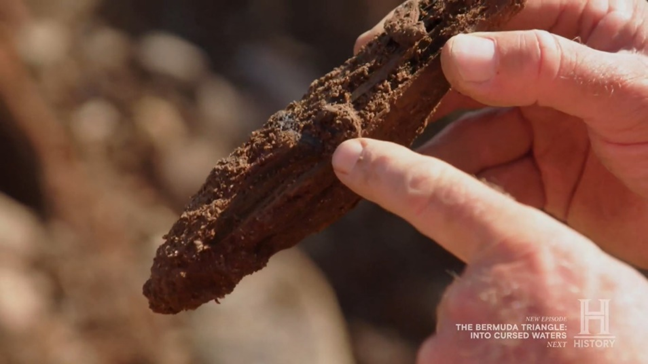THE CURSE OF OAK ISLAND – THE HISTORY CHANNEL (Both Pics)
In last night’s episode, “Chain Reaction”, Rick, Alex and Gary are working in the southeast corner of the Swamp near the stone road feature when another chain and hook were found. Gary inspects the chain and states that it looks old, and he believes it was used for loading and unloading cargo in the Swamp area. Another chain and hook were found in last week’s episode and is awaiting analysis in Emma Culligan’s lab at the Interpretive Center.
THE CURSE OF OAK ISLAND – THE HISTORY CHANNEL (Both Pics)
While continuing to work in the area, Gary then finds pieces of wood with iron spikes embedded in them. He believes the spike in the wood is a rose head spike and dates the piece from the 1700’s or older. The team believes that this may indicate some sort of structure was built in this area. This brings up Fred Nolan’s belief that a Dam feature was built in the Swamp. To be fair, it should be noted that Fred also believed and had evidence that the Swamp was used as a dump by the residents of the island in the 1800’s, so it’s not surprising that something is always found in the marshy bog.
THE CURSE OF OAK ISLAND – THE HISTORY CHANNEL (All Pics)
Next, we are taken to the Interpretive Center where archeologist Laird Niven is there to reveal some information on a couple of objects previously found at the Lot 5 excavation area. The first piece is the engraved stone that was found by archeologist Jamie Kouba. After an XRF scan, Emma Culligan reported there was iron residue in the groove of the stone that indicated, as Laird suggested, that the piece was a whetstone that was used for sharpening tools and knives. The other artifact was identified by Jamie Kouba as decorative metal, maybe from a chest or drawer. This seems to be inaccurate as the piece resembles a crochet hook, but the team was unclear of the exact identification of the artifact. Emma said the iron composition of the piece is English, possibly dating to the late 1600’s to 1700’s and similar, but not exact to the William Phip’s artifacts from Maine previously mentioned several times in continuous episodes.
THE CURSE OF OAK ISLAND – THE HISTORY CHANNEL (Both Pics)
The scene shifts to the Lot 5 excavation site, where the archeologists and Jack Begley are working the area. It’s mentioned that they believe there was a staircase and cellar in the structure. Archeologist Helen Sheldon shows Jack a piece of unglazed stoneware that was found at the site that dates from the mid 1600’s to mid-1700’s. Archeologist Jamie Kouba then discovers a glass bead that she proposes is perhaps Venetian. This then begins speculation that this site could be much older than they originally thought. It’s important to remember that glass beads of this sort were used for trade with the indigenous populations. It’s very possible that this piece was used by whoever was on Oak Island to trade for things they needed with the local Mi'kmaq in the area, most likely from the 1600’s to 1700’s.
THE CURSE OF OAK ISLAND – THE HISTORY CHANNEL (All Pics)
We are then taken back to the Interpretive Center, where blacksmith Carmen Legge visits to render his opinion on some of the recent finds by the team. Carmen inspects the pieces of wood with spikes embedded in them and suggests that they could be part of an underground structure that was used to illuminate an area by hanging something up like a lantern. He then inspects another artifact that was found that Gary suggested may have been a wrought iron fastener dated from the 1700’s or older. Carmen suggests that it was a tool, a set to drive pins into wood. He suggests that it may have been used for planking in shipbuilding. This would reinforce the possibility of shipbuilding going on at Oak Island that the Compendium has previously suggested. Carmen then looks at the chain that was discovered last week that had the three other chains connected to the main chain and hook. He suggests it was used as a boon for cargo such as treasure chests. He says that the main chain and hook are old and handmade dating to no later than 1650 but adds the three other chains are more modern and machine made. This suggests to the Compendium that the main piece was repurposed for a very long period of time and not necessarily indicating someone being on the island in 1650.
THE CURSE OF OAK ISLAND – THE HISTORY CHANNEL (Both Pics)
NASA
The episode concludes when the team meets in the War Room to discuss imaging results from Aladdin’s Cave. While looking at the images, a part of the cave is shown that looks like a right angle. Dr. Ian Spooner remarks, “You would not get that right angle naturally.” Dr. Spooner’s credentials according to the Acadia University website, “Ian Spooner (P. Geo, Ph.D.) has been a professor at Acadia in the Department of Earth and Environmental Science for the past 26 years. He has supervised 30 master’s and 48 B.Sc. honours theses to date…He has served with a number of professional organizations and was recently awarded the Distinguished Service Award by the Atlantic Geoscience Society and the Acadia Faculty of Pure and Applied Science Teaching Award.” What’s concerning about Dr. Spooner’s statement is that you can get right angles in nature. It’s not commonplace but yes, it’s possible. An example would be one that was viewed on Mars by NASA. We anticipate an appearance by Dr. Spooner on Ancient Aliens coming soon. Until next week.
Good day from the Compendium!















